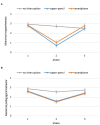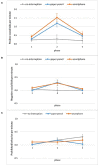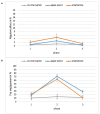Quality of Mother-Child Interaction Before, During, and After Smartphone Use
- PMID: 33854461
- PMCID: PMC8039320
- DOI: 10.3389/fpsyg.2021.616656
Quality of Mother-Child Interaction Before, During, and After Smartphone Use
Abstract
Studies have demonstrated that parents often exhibit a still face while silently reading their cell phones when responding to texts. Such disruptions to parent-child interactions have been observed during parental media use such as texting and these disruptions have been termed technoference. In the present study, we explored changes to mother-child interactions that occur before, during and after interruptions due to texting using an adapted naturalistic still face paradigm. Specifically, we examined the effect of an interruption due to either maternal smartphone use or use of an analog medium on maternal interaction quality with their 20- to 22-month-old children. Mother-child interactions during free play were interrupted for 2 min by asking the mothers to fill out a questionnaire either (a) by typing on the smartphone (smartphone group) or (b) on paper with a pen (paper-pencil group). Interactional quality was compared between free-play and interruption phases and to a no-interruption control group. Mixed ANOVA across phase and condition indicated that maternal responsiveness and pedagogical behavior decreased during the interruption phase for both the interruption groups (smartphone and paper-and-pencil) but not for the no-interruption group. Children also increased their positive bids for attention during the paper-and-pencil and the smartphone conditions relative to the no-interruption control. These findings are consistent with a large body of research on the still-face paradigm and with a recent study demonstrating that smartphone interruptions decreased parenting quality. The present study, however, connects these lines of research showing the many everyday disruptions to parent-child interactions are likely to decrease parenting quality and that toddlers are likely to detect and attempt to repair such interruptions.
Keywords: interactional quality; interruption; media use; parent-child interaction; smartphone; still face; technoference.
Copyright © 2021 Konrad, Hillmann, Rispler, Niehaus, Neuhoff and Barr.
Conflict of interest statement
The authors declare that the research was conducted in the absence of any commercial or financial relationships that could be construed as a potential conflict of interest.
Figures




References
-
- Abels M., Vanden Abeele M., van Telgen T., van Meijl H. (2018). Nod, nod, ignore: An exploratory observational study on the relation between parental mobile media use and parental responsiveness towards young children, in The Talking Species: Perspectives on the Evolutionary, Neuronal, and Cultural Foundations of Language, Luef E. M., Marin M. M., eds. (Graz: Uni-Press Verlag; ), 195–228.
-
- Adamson L., Frick J. (2003). The still face: A history of a shared experimental paradigm. Infancy 4, 451–473. 10.1207/S15327078IN0404_01 - DOI
-
- Ainsworth M. D. S., Bell S. M. (1974). Mother-infant interaction and the development of competence, in The Growth of Competence, Connolly K., Bruner J., eds. (London, New York, NY: Academic Press; ), 97–118.
-
- Barr R., Linebarger D. N. (eds.) (2017). Media Exposure During Infancy and Early Childhood: The Effect of Content and Context on Learning and Development. New York, NY: Springer.
LinkOut - more resources
Full Text Sources
Other Literature Sources

